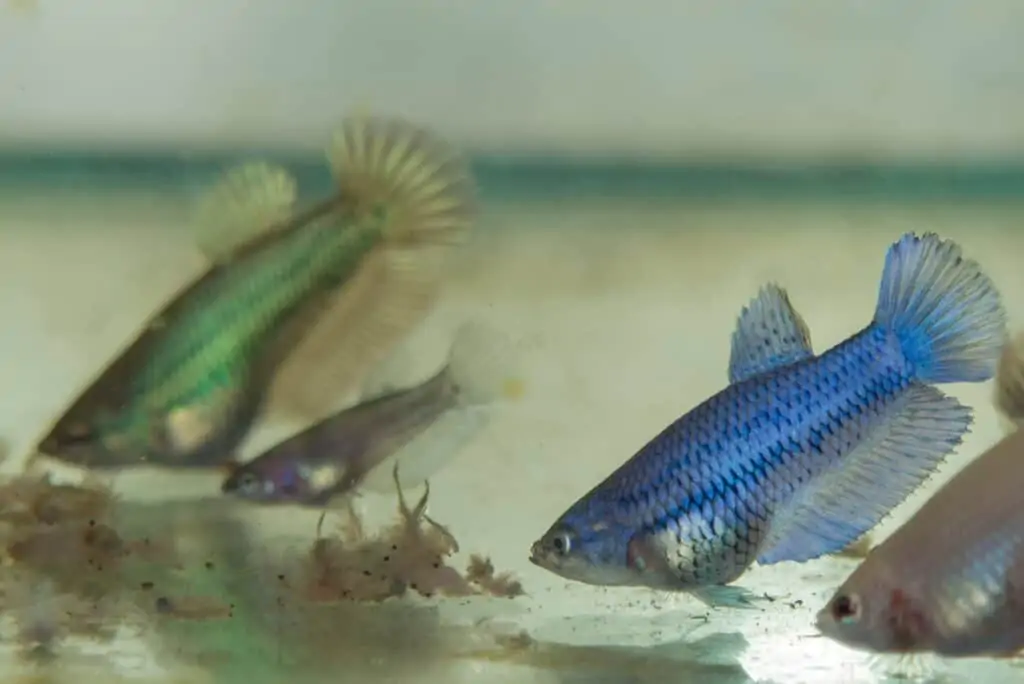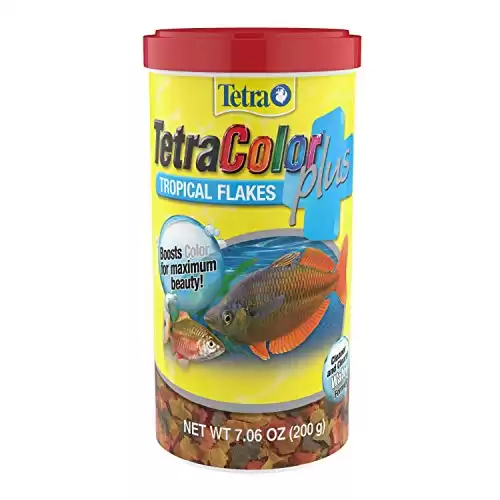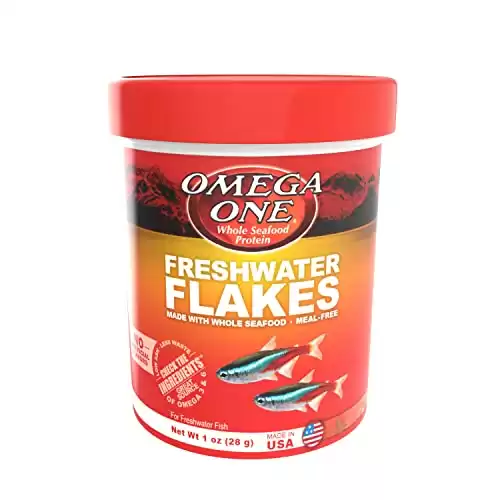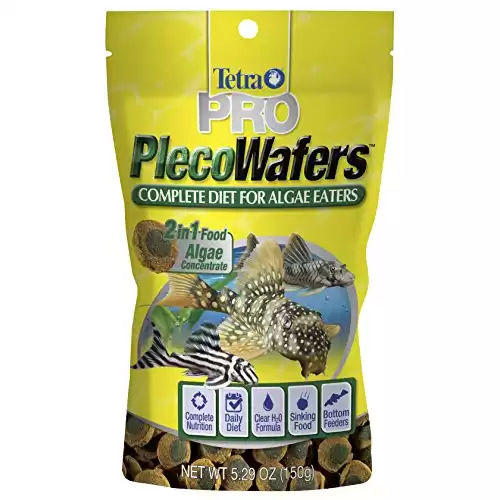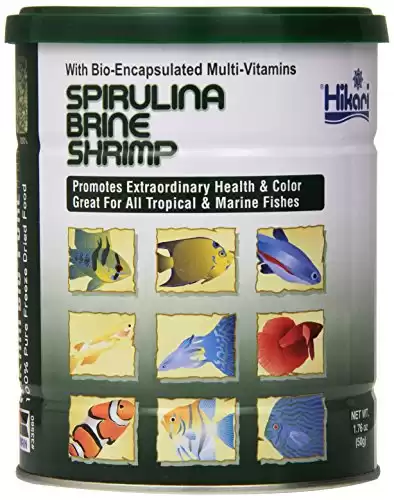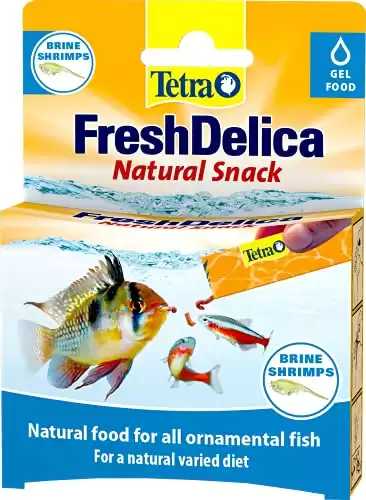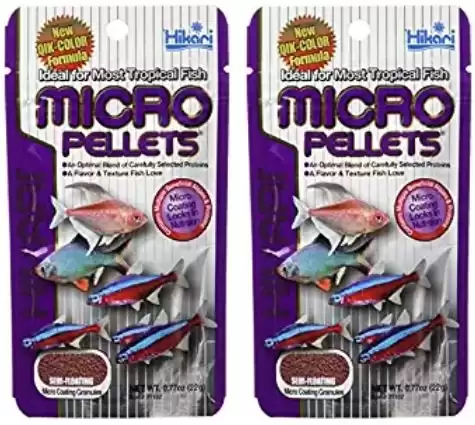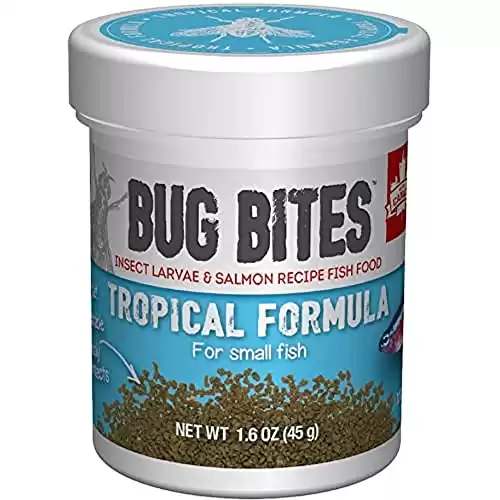As well as providing them with the correct environment, a high-quality, balanced diet is absolutely crucial for your fish’s health. But with such a mind-boggling range of tropical fish foods out there, how do you know what to choose?
In this guide, you can learn what to look for in the best tropical fish foods and discover the highest quality foods on the market today.
|
4.8
|
4.7
|
4.7
|
7 Best Tropical Fish Foods
Here are seven of our favorite tropical fish foods that are currently available on the market.
Omega One Freshwater Flakes
- NUTRITIOUS RECIPE: Freshwater Flakes are blended specifically to enhance the levels of Omega 6 fatty acids. Omega 6 fatty acids are extremely valuable to freshwater species for strong immune systems and cell wall development
- COLOR-BOOSTING: Natural beta carotenes in salmon provide excellent color enhancement
- SUPERIOR QUALITY: No meals, hydrolysates, digests, or any other pre-processed protein
Omega One Freshwater Flakes is a very high-quality tropical fish food containing carefully balanced ingredients, including herring, halibut, salmon, whole shrimp, kelp, and cod. This formulation is carefully created to enhance your fishes’ bright colors and encourage fussy feeders.
The only downside to this food is that it contains some legumes and grains, albeit in minimal amounts.
What we like:
- Contains whole fish
- Natural color-enhancing qualities
- Excellent for tempting fussy feeders
Room for improvement:
- Contains a small quantity of grains and legumes
Hikari Bio-Pure Spirulina Brine Shrimp Cubes
- Patented Ratcheting Dispenser Top
- Will not cloud the water
- Multi-vitamin rich to reduce stress and stress related diseases
Hikari Bio-Pure Spirulina Brine Shrimp cubes is a freeze-dried food that makes a delicious supplement or treat for your fishes’ diet.
To feed your fish, simply crumble a cube into the aquarium water or push one onto the tank wall so that the fish can nibble on it.
What we like:
- Makes a nutrient-packed treat for your fish
- Contains no fillers or artificial additives
- A pure source of protein
Room for improvement:
- Does tend to be messy in the tank
Tetra Algae Wafers
- PLECO FORMULATION: Supports the nutritional needs of herbivore bottom-feeders such as Plecostomus
- SINKING WAFERS WITH CONCENTRATED ALGAE: Provides a complete, balanced diet for algae eaters
- ALL-VEGETABLE SUPPLEMENT: Easily digested vegetarian fish food that’s naturally high in fiber
If you have algae eaters, but not enough algae growth in your tank to support them, these algae wafers are the ideal supplement.
The wafers are designed to sink immediately, making them perfect for bottom-dwellers. The food has a vegetable-enriched outer layer encasing a concentrated algae center and also contains essential vitamins for optimum health and vitality.
What we like:
- Perfect for bottom-feeders and herbivorous fish
- Contains added vitamins
- Doesn’t cloud your tank water
Room for improvement:
- Contains a few fillers
Tetra Freshdelica Brine Shrimp
- Sterilised - no need for storage in a fridge or freezer
- 2 year shelf life
- Delivery available to UK and International addresses.
Tetra’s Freshdelica products are extremely popular with fish and hobbyists alike! My fish love these handy sachets of tasty gel, which make the ideal nutritious treat. The gel comes in a variety of delicious flavors that your fish will go crazy for!
The main downside to this food is that it’s quite pricey compared with fish flakes and pellets. However, the gel does have a two-year shelf-life.
What we like:
- Excellent source of meaty protein
- Contains no additives or preservatives
- 2-year shelf-life
Room for improvement:
- Expensive compared with flakes and pellets
Hikari Tropical Micro Pellets
Hikari is a producer of extremely popular and very high-quality fish foods. These tiny pellets are formulated with small fish species in mind, such as tetras, rasboras, and bettas.
The carefully balanced formula includes a mix of vegetable and marine proteins, as well as spirulina and krill for natural color enhancement. The soft pellets are semi-floating so that all your fish can enjoy them, regardless of where they swim in the water column.
What we like:
- Ideal for very small fish
- Does not cloud water
- Semi-floating pellets
Room for improvement:
- Tiny pellets can clog filter inlets
TetraColor Plus Tropical Flakes
- TROPICAL FORMULATION: Highly digestible flake formula for use as staple food for all tropical fish.
- PLUS COLOR ENHANCEMENT: Rich in carotene and other ingredients to bring out natural pink to orange-red coloration.
If you have brightly colored tropical fish species, such as Rainbowfish, Ember tetras, and the like, TetraColor Plus Tropical Flakes are definitely the food you want.
These high-quality flakes contain a natural blend of ingredients, including carotene, to enhance your fishes’ pink to orange-red coloration. The formula is packed with protein derived from specialized fish meal, helping to make this food highly digestible.
What we like:
- High-protein formula for easy digestibility
- Does not cloud water
- Contains natural color enhancers
Room for improvement:
- More expensive than other similar products
Fluval Bug Bites Tropical Fish Food
- Tropical fish food that contains up to 40%, nutrient-rich Black Soldier Fly Larvae, the first ingredient
- High in multiple proteins like whole salmon – rich in Omega 3 and 6 for healthy skin, scales and fins
- Fortified with essential vitamins, amino acids and minerals for a balanced daily diet
Fluval is a major player in the hobby, producing many different kinds of high-quality fish foods and other products for the aquarist.
This hugely popular pellet food contains up to 40% black soldier fly larvae as its base ingredient and whole salmon. This nutrient-rich food also contains Omega-3 and Omega-6 for skin and scale health. Vitamins, minerals, and amino acids help boost vitality and are excellent for promoting immune system health.
What we like:
- High-protein formula for excellent digestibility
- Does not cloud water
- Contains natural color enhancers
Room for improvement:
- More expensive than other similar products
Tropical Fish Feeding Basics
It goes without saying that you should always buy the very best high-quality fish food for your pets that your budget allows, such as those products included in our list.
Avoid Overfeeding
As well as buying an excellent quality product, you must be careful that you don’t overfeed your fish.
We recommend that you feed your healthy fish only two or three times per day. Only give your fish what they will clear within a couple of minutes. If you’re not able to feed your fish manually due to work or school commitments, it’s well worth investing in an automatic feeder. Simply load the feeder with the correct amount of food and preset it for your fishes’ feeding times.
Nocturnal fish species are active at night or just before the lights go out, which is when you need to feed them. Goldfish and bettas should have one day per week when they’re not fed at all. A fasting day helps prevent common digestive problems, such as swim bladder issues, constipation, and bloating, that can affect these species of fish.
Overfeeding causes many serious problems, including:
Cloudy Water
Uneaten food sinks to the bottom of the tank, where it decomposes in the substrate, polluting the tank water and turning it cloudy.
Algae Bloom
Did you know that overfeeding is the primary cause of outbreaks of algae in your fish tank?
Leftover fish food causes large volumes of organic material, dissolved nitrates, and phosphates to build up in the water, providing excellent nutrition for algae and causing the organisms to bloom.
Low Oxygen Levels
Many community fish species, including bettas, gouramis, and goldfish, require high levels of oxygen in the water. Oxygen is used as part of the aerobic decomposition mechanism of organic matter, and CO2 is produced. That depletes the level of dissolved oxygen in the water, potentially stressing your fish.
Mold and Fungus
Mold and fungus just love an environment with plenty of organic matter in the water. So, if you spot lots of cotton-like material coating your aquatic plants or substrate, that’s a sure sign you’re overfeeding your fish.
Planaria Worms
Even though planaria worms won’t do any harm to your fish, you often see them living in aquariums where the fish are overfed, effectively telling you that there’s a problem with your water quality.
These tiny tan or white worms are often seen crawling up the viewing panes, especially at night.
Clogged Filter Media
If your filtration system is running efficiently, the water in your aquarium will be kept safe for your fish.
However, excess food floating in the water can clog the filter media, preventing the filtration system from running efficiently. Clogged filter media prevents the water from flowing through the system. That quickly causes the water quality to decline drastically, potentially poisoning your fish.
High Levels Of Ammonia and Nitrites
Decomposing fish food and fish waste release ammonia and nitrites into the water as they break down, creating a highly toxic environment. So, if you overfeed your fish, you’re potentially overloading the filter and poisoning the water.
Lowered pH Levels
The acids produced when organic material decomposes can lower the water pH.
All fish species have a preferred pH range. If the pH is outside the fishes’ tolerance, they will quickly become stressed. Stress causes the fishes’ immune systems to become compromised, making them susceptible to attack by bacteria and parasites.
Surface-Feeders vs. Bottom-Feeders
Most catfish species are bottom-feeders. On the other hand, Bettas and Gouramis are surface-feeders, whereas schooling fish, such as Tetras and Rasboras, tend to feed at the water surface and on food that falls through the water column to the mid-range.
So, when choosing food for your fish, you need to factor in where the fish prefer to feed and buy suitable products accordingly. For example, bottom-dwellers need sinking wafers, while surface-feeding fish species do best when fed floating pellets.
Feed Your Fish A Balanced, Varied Diet
In nature, all fish species enjoy a varied diet that provides them with the balanced nutrition they need to thrive, so in the captive environment, variety is a must.
Most commercially prepared fish foods are formulated to contain a carefully balanced mixture of beneficial nutrients to ensure that your fish get everything they need for excellent health and brilliant color. But the same food can get boring after a while. So, be sure to include a few blanched fresh veggies and frozen meaty foods, such as bloodworms and brine shrimp, to mix things up and keep your fish happy.
How To Choose The Best Tropical Fish Food
Not all tropical fish food is the same, and there are a few crucial things to watch out for when choosing the best product.
Essential Ingredients
Regardless of whether your fish are carnivores, herbivores, or omnivores, there are certain substances that all fish need in their daily diet. The proportions and sources of those substances vary depending on the type of fish, but essentially, the food groups are:
- Protein (amino acids)
- Fats (lipids)
- Carbohydrates
- Vitamins B, C, and E
- Riboflavin
- Niacin
- Biotin
- Zinc
- Manganese
Ingredients to look out for include:
- Whole fish
- Algae meal
- Krill
- Spirulina
- Squid meal
- Earthworms
- Black soldier fly larvae
- Black worms
Look for at least one of those items in the first two places in the ingredients list on the product packaging.
Ingredients To Avoid
Cheap brands of dry fish food often contain padding and fillers that have no nutritional value and are purely there to give bulk to the food.
Those ingredients include:
- Soybean meal
- Sorbitol
- Wheat flour
- Potato protein
Although these carbohydrates won’t harm your fish, you don’t want to see them near the top of the ingredient list.
Poor-Quality Fish Meal
Fish meal is often used in fish foods. However, there are two common types of fish meal; cheap, generic fish meal and high-quality fish meal.
Fish owners want to see a high-quality fish meal on the ingredients list. That kind of fish meal is a by-product of fish processing for human consumption. Although this product is not suitable for you and me to eat, it’s excellent for fish, as it’s rich in protein and Omega-3 fatty acids.
Low-quality fish meal is essentially waste products; bones, skin, scales, and other inedible stuff. That is all ground up to create a low-quality fish meal. Watch out for whole fish derivatives, as that indicates that high-quality fish meal has been used.
Legumes and Grains
Many cheap fish foods contain grains, such as soy and wheat. Fish don’t naturally eat those foods, so their digestive systems are not geared to process them. Consequently, most of that food simply ends up in the water column as a pollutant.
So, if grains or legumes are shown as the first couple of ingredients on the food packaging, it’s cheaper food.
What Different Kinds Of Tropical Fish Foods Are There?
There are several different types of fish foods:
Flake Foods
Flake food is probably the most popular fish food for surface and mid-water feeders. The key ingredients are dehydrated and processed into paper-thin sheets that are baked to create flakes.
When the flakes soak up water, they slowly sink to the substrate, where your bottom-dwelling fish can grab them.
Pellet Foods
Pellet foods are formulated to either float or sink. Floating pellets are perfect for surface feeders, whereas sinking pellets are designed to slowly drift down through the water column, enabling mid-water and bottom-dwellers to get their share.
Pellets come in different sizes, too, to suit small and larger fish.
Sinking Discs And Wafers
Sinking wafers and discs are generally marketed as suitable for bottom-dwelling fish. However, you do need to check that the product contains plenty of algae, as these foods are often of poor quality and packed with fillers.
Gel Foods
Gel foods sometimes come ready-mixed in sachets that you simply squeeze into the water for your fish. Other gel food has to be mixed with hot water and allowed to set before you can use them.
Although fish love gels, they can be pretty expensive and are not suitable for a basic staple diet.
Freeze-Dried Fish Foods
Freeze-dried fish foods can make a nice meaty protein treat for your pets. You can buy freeze-dried brine shrimp, bloodworms, and similar.
Frozen Foods
Although all carnivorous and omnivorous fish love live foods, that can spell trouble in the form of imported parasites, bacteria, and other nasties that can wreak havoc in your tank.
However, your fish can still enjoy the taste and nutritional value of meaty proteins in the form of frozen food, including:
- Bloodworms
- Mosquito larvae
- Daphnia
- Brine shrimp
- Tubifex worms
Frozen fish foods come in neat trays of flash-frozen cubes that you can easily store in your home freezer. Before feeding, thaw the cubes in a bit of tank water, and pour the whole lot into your aquarium.
Live Fish Foods
As mentioned above, many fish species enjoy live foods. However, the problem with using live foods is that they often harbor parasites and bacteria that you really don’t want in your fish tank.
For that reason, I recommend that you go for the frozen or freeze-dried option instead of live foods. However, if you want to feed live foods, you might want to consider setting up a home brine shrimp hatchery so that you know exactly where the food has come from.
Final Thoughts
We hope that you enjoyed our guide to the best tropical fish food.
You must feed your fish high-quality tropical fish food to keep your fish healthy and thriving. Is your fish a carnivore, omnivore, herbivore, surface-feeder, or bottom-feeder? Choose a food that suits your fishes’ natural preference and feeding habits. Finally, be careful not to overfeed your fish, as that can cause problems with your fishes’ health and the water quality in your aquarium.
What’s your preferred type of fish food? What kind of fish do you have? Tell us in the comments box below, and remember; sharing is caring!

